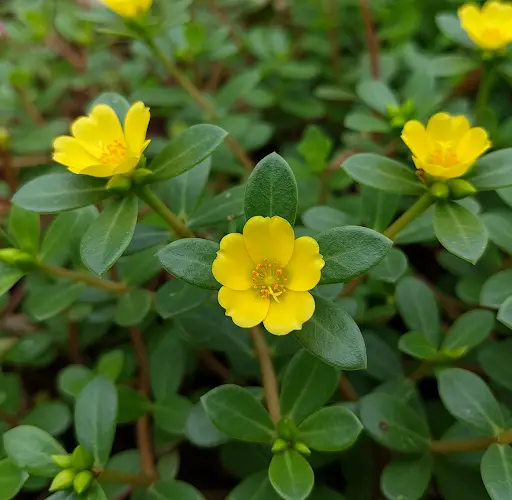Purslane: The Superfood Hiding in Your Garden (And How to Turn It into a Refreshing Salad)
Often overlooked and commonly pulled out as a weed, purslane is one of nature’s hidden gems. Known by various names around the world—including “Tust” in some regions—this resilient plant thrives in almost all types of soil and climate conditions. Despite its humble appearance, purslane boasts an impressive nutritional profile and has been used since ancient times for its medicinal and culinary properties.
What is Purslane?
Purslane (Portulaca oleracea) is a low-growing succulent with thick, fleshy leaves and reddish stems. It’s often found creeping along garden beds, sidewalks, and even between patio stones. Many gardeners see it as a nuisance and discard it without realizing the value it holds.
Historically, purslane was appreciated in both Ancient Greek and Traditional Chinese Medicine. It was prized for its diuretic and laxative properties, as well as its ability to detoxify the body. Modern research confirms much of what ancient civilizations already knew—purslane is a powerhouse of nutrients.
Nutritional Benefits of Purslane
Purslane is remarkably rich in vitamins and minerals. It contains:
-
Vitamin A, which supports eye health and boosts the immune system.
-
B-complex vitamins such as riboflavin, niacin, and pyridoxine, which aid in energy production and metabolism.
-
Vitamin C, known for its antioxidant and immune-boosting properties.
-
Minerals like potassium, magnesium, calcium, iron, zinc, and selenium, all of which play critical roles in bodily functions.
Perhaps the most remarkable feature of purslane is its high omega-3 fatty acid content—especially alpha-linolenic acid (ALA), which is typically found in flax seeds and fish oil. Purslane contains more omega-3s than any other leafy vegetable, making it especially valuable for vegetarians and vegans.
Health Benefits
Regular consumption of purslane can offer a wide array of health benefits:
-
Anti-inflammatory effects: Useful in treating discomfort and swelling, particularly in the urinary and digestive systems.
-
Improved digestive health: High fiber content helps combat constipation and promotes regular bowel movements. It may also help prevent gastritis, ulcers, and intestinal parasites.
-
Heart health support: Omega-3s, potassium, and magnesium help regulate blood pressure, improve circulation, and reduce the risk of arrhythmias.
-
Skin, hair, and joint nourishment: The combination of vitamins and minerals supports tissue regeneration and hydration.
-
Immunity and detoxification: Antioxidants and vitamins help neutralize toxins and strengthen the body’s defenses.
-
Natural fever reducer: Purslane has been used traditionally to lower body temperature and alleviate chills.
Growing and Harvesting Purslane
Because purslane grows in nearly any environment, it’s easy to cultivate in your garden. However, it’s best to plant and harvest it in a location free from pollution or chemical contamination, especially if you plan to eat it fresh. Harvest the young leaves and tender stems, preferably before the plant starts flowering, as they offer the best flavor and texture.
How to Make a Simple and Delicious Purslane Salad
One of the easiest and tastiest ways to enjoy purslane is in a fresh salad. Here’s a simple recipe that brings out its natural flavor while pairing it with healthy ingredients.
Ingredients:
-
A handful of fresh purslane leaves and tender stems, thoroughly washed
-
2 tablespoons of sour cream or thick natural yogurt
-
Salt to taste
-
A drizzle of olive oil
-
A pinch of ground black pepper
-
A light sprinkle of ground red pepper or paprika (optional)
Instructions:
-
Rinse the purslane leaves and stems under cold water to remove any soil or debris. Pat them dry with a clean towel.
-
Place the cleaned purslane into a bowl.
-
Add the sour cream or yogurt and mix well to coat the leaves evenly.
-
Season with salt, olive oil, black pepper, and ground red pepper to taste.
-
Mix gently until everything is well combined.
This salad is wonderfully refreshing and hydrating—perfect for hot days. The sour cream or yogurt adds creaminess, while the spices and olive oil enhance the natural lemony tang of purslane. It’s not just healthy; it’s also an excellent thirst-quencher and light enough to serve as a side dish or a light lunch.
Final Thoughts
Purslane proves that sometimes the most nutritious foods are growing right under our noses. Far from being a useless weed, it’s a resilient, nutrient-rich plant with a wide range of health benefits. By incorporating purslane into your diet—especially through simple recipes like this salad—you can enjoy a natural, affordable boost to your well-being.
So next time you spot this little green plant in your garden, don’t pull it out—pick it, wash it, and turn it into something delicious.



